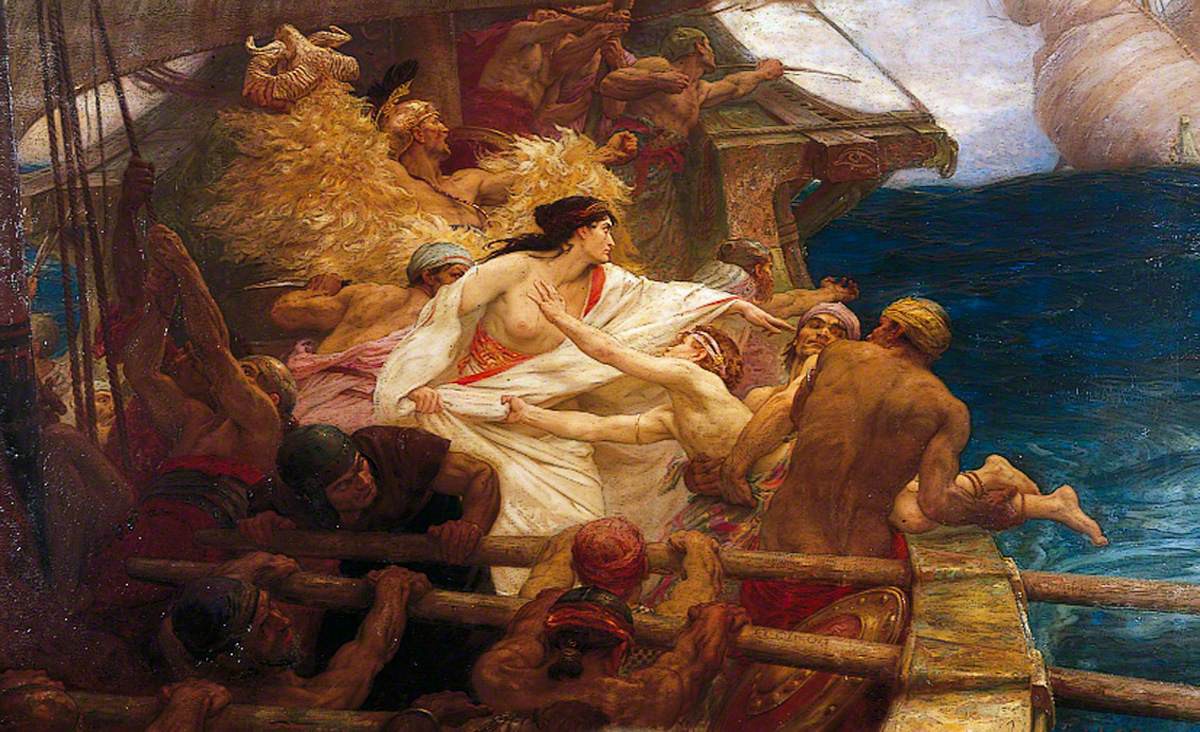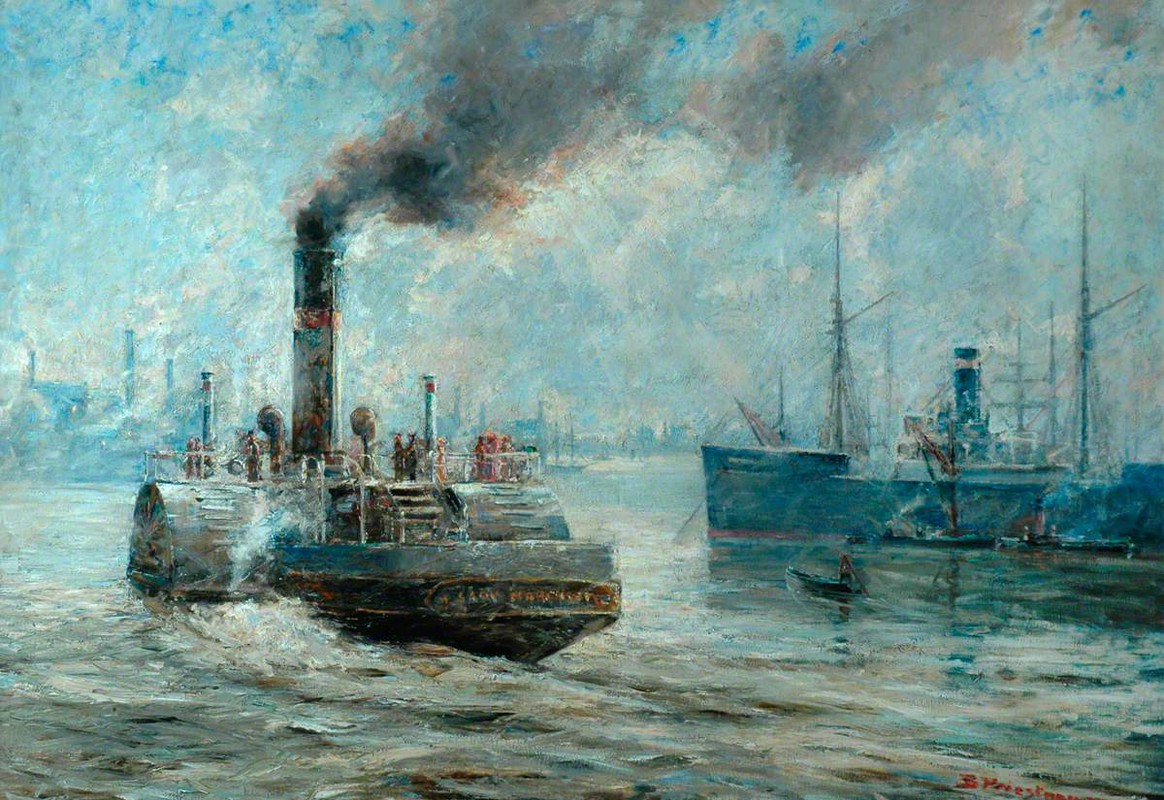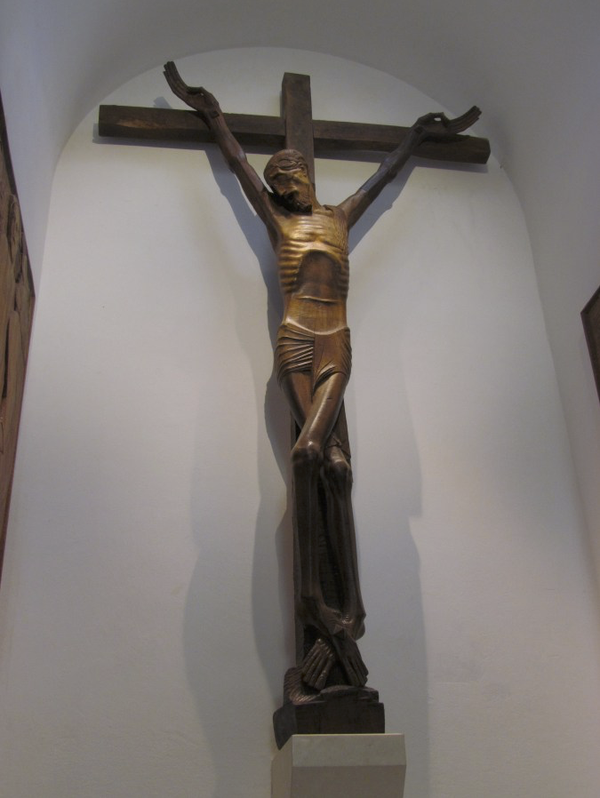
The Golden Fleece (1905) by Herbert James Draper (1864–1920). One of the paintings in the Cartwright Gallery which impressed Richard as a young boy with its sense of drama
And so we come to the Art Gallery and Museum.
It is the kind of building that a child would love to make with toy bricks, those expensive sets that have arches and balustrades and pillars and tops for turrets. As one approached it the Gallery looked rather prison- like. The windows are high up so it is impossible to see into the rooms. There is a portico with a domed ceiling. Here we jump on the asphalt under it and get a series of scattered echoes like pistol shots. We go up some clean steps to some cumbersome glass panelled doors. These swing doors with their huge ornate handles are really a test of strength. Beyond them we can see further steps and a wonderful white hall lit from high windows, the light coming down on to white statues in marble, a strange frozen world somehow lacking in life. Our nostrils are flooded by the smell of floor polish as we go in. We are watched by the porter with the fierce waxed moustache. We walk with a clatter and more echoes vibrate over the large black and white marble tiled floor to the left. This room at the end is one we often visit.
There are glass cases full of stuffed birds all arranged in the natural surroundings. The blue green glass for water, the sand and pebbles and plants are beautifully put together, with the birds flying above. They shake a bit as we walk on the floor but we can’t find out how they are fixed in their flight. There are some small aquariums, mostly full of water snails, and cabinets full of butterflies. A large head of a buffalo with a tremendous spread of horns, shot by a local man, stares at us from one wall. I am worried about this shooting. But the main exhibit, often left to the last, is under the far window. This is a model several feet long of a railway engine complete with tender with real coal in it.
I have never known anything about the working of machines nor have I wanted to. The pleasure I get from machines is an appreciation of the proportion of one part to another. Looking at the cab of the engine with all the levers and handles, I could project myself into it and imagine the feel of being enclosed in that space and looking through those circular windows along the whole length of the boiler and the short shiny funnel. I know from observation that the stoker would walk along the outside, holding onto the brass rail till he got to the front and would open the huge circular oven door and look in. What he would have seen or what is in there I don’t know to this day.
There are three rooms of drawings and watercolours on this floor but unfortunately blinds have been drawn down to prevent the sun getting in. This makes it rather depressing so we go up one of the stone staircases to the large galleries above.

The Golden Fleece (1905) by Herbert James Draper (1864–1920). One of the paintings in the Cartwright Gallery which impressed Richard as a young boy with its sense of drama
I do not remember seeing real paintings for the first time but there were several large pictures in the permanent collection, which I grew up with into my teens. Jason and the Golden Fleece was a large painting of a chase at sea as seen from a galley. A naked youth is being thrown overboard so as to halt the ship appearing behind the great blue green waves with its great sail billowing in the wind. A soldier in the galley holds up the Golden Fleece in a gesture of defiance. This painting, and others like it I held in the same esteem as I did the illustrations in The Boys' Own Paper. What the difference was between Herbert Draper's painting and an illustration by Caton Woodville I find it difficult to define. Perhaps there was none. But there was a painting by Bertram Priestman: A Hazy Day on Rochester River painted in great slabs of paint which I always admired for its vigour and breadth and of course, it had a paddle steamer in it which was in its favour.

A Hazy Day on the Rochester River (1895) by Bertram Priestman (1868–1951). Another painting which he remembered perhaps for more artistic reasons
There were also some pictures of landscape that interested me. These were all of quarries or chalk pits. The play of light on the surfaces of rocks I could understand but paintings of views with lots of trees found me wondering what to look at.
As new acquisitions were made I used to go and see them. It was a great day when D.Y. Cameron's Marble Quarry arrived, and there was a life-size William Etty. This standing figure was one of the first paintings I had seen in which there were no accessories or false landscape background. I usually looked at it when there was no one else in the room. Mother thought it wrong to paint naked women and Father, strangely enough, seemed to share this view. I tried showing him, when I became a student, some of the pictures by the old masters that I liked. I found that he tolerated the nude more or less when it was used in decorations of the Boucher type, though he thought all French painting frivolous and that it reflected their general taste. But I noticed when we came to Rubens that they became harder to look at and when I eventually showed him Rembrandt's wonderful little painting in the National Gallery of the woman wading, he became quite angry and said it was not Art. I was quite taken by surprise. Apparently it was all right to idealise the nude but when a painter demonstrated that he had really looked at a naked figure and loved its warmth and fleshiness, the bounds of art were overstepped.
This nude of Etty's had the advantage that the head of the model was turned away from the spectator so that one was never involved in thinking of her as a personality and could look at the painting and its richness quite unabashed.
It took me some time to appreciate Buxton Knight's painting of a slipway in Portsmouth Harbour. The paint was thick and heavy and the boats and figures lacked shape but I gradually came to see that the design was very unconventional and that the light and breeziness portrayed was the subject of the picture. Mark Fisher’s picture of an orchard with sheep under the apple trees puzzled me in the same way, though I liked J.M. Swan's Leopards in vivid ochre and greens and blue because it gave the feline qualities of the animal which I admired. But sheep seemed such listless, timid things, all looking alike. I could understand George Clauson's The Man and the Boy. Two large figures are hoeing a field, the old man with his head down getting on with the work while the youth straightens up for a minute and looks across the fields at his home, (or hers). Sentimental perhaps, but the painting was interesting in its unconventional thickness and pure colour. These and some rather bad pictures by local artists were the paintings I grew up with.
But a shock was in store. During the First World War an exhibition which had been shown in London of Serbian sculptures and painting came to Bradford. I had never seen anything of the kind by living artists. The paintings were blazing with decorative colour, a kind of painting unfamiliar to me. The newspapers informed us that it was like 'peasant art' so I accepted it as such. But the sculpture! - I think nearly all these large works were by Ivan Mestrovic - two of the sculptures moved me as I had not been moved before. One of the artist’s Mother was rigid and quiet with a detached unemotional calm which gave the feeling that it had always existed.

The other could hardly have been more different: an enormous crucifix constructed with great logs of wood, great iron nails driven through the hands and feet, the figure emaciated and elongated, the hands and feet like flippers, the whole thing terrifying. All my elders and betters said it was awful. The local newspapers made jokes about it. I didn't know what to think. Father had no time to see exhibitions and I rather felt that I would be told it wasn't Art. But under the influence of the impact I tried to carve a head in relief on a piece of oak I had found among some kindling wood. I did not show it to anyone. Mother sometimes came with me to see the local or Yorkshire Artists Exhibitions. We had become acquainted with several families who apparently took art seriously, so Mother realised she ought to know something about the local painters, particularly as Father's family had been mixed up with the Rothensteins and Priestmans and Delius families.
When I had the audacity to send a picture to one of these exhibitions and it was accepted and hung, I had very mixed feelings. For one thing I realised at once that the painting was atrocious and felt ashamed, particularly as Father was rather proud of it and its acceptance. And then a message was sent to me from my former kindergarten mistress that she had taken the whole school to see my painting and they were proud of me! There was just one redeeming feature in the case and that was that the picture was hung in one of the gloomy downstairs rooms between two windows so that it could not be seen at all.
Thirty years later I looked into that room and remembered my humiliation but upstairs I had seventy paintings on view in the big gallery as part of the 1951 Festival Year.